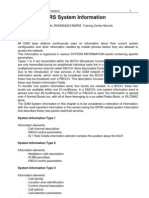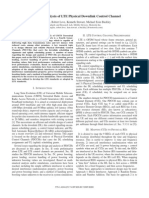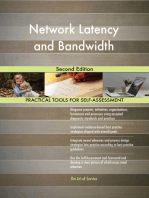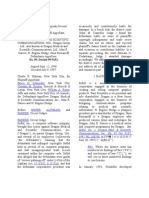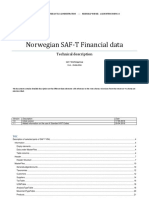Self Organising Networks (SON) : Phaniteja K RNO Huawei
Self Organising Networks (SON) : Phaniteja K RNO Huawei
Uploaded by
Kondapalli Phani TejaCopyright:
Available Formats
Self Organising Networks (SON) : Phaniteja K RNO Huawei
Self Organising Networks (SON) : Phaniteja K RNO Huawei
Uploaded by
Kondapalli Phani TejaOriginal Title
Copyright
Available Formats
Share this document
Did you find this document useful?
Is this content inappropriate?
Copyright:
Available Formats
Self Organising Networks (SON) : Phaniteja K RNO Huawei
Self Organising Networks (SON) : Phaniteja K RNO Huawei
Uploaded by
Kondapalli Phani TejaCopyright:
Available Formats
Security Level:
Self Organising Networks
(SON)
Phaniteja K
RNO
Huawei
www.huawei.com
Author/ Email: Author's name/Author's email
Version: V1.0(20YYMMDD)
HUAWEI TECHNOLOGIES CO., LTD.
Contents
Overview
Introduction
Eden-NET Architecture
Eden-NET Modules
Overview
1. New user devices and evolving network usage has dramatically increased user demand for mobile
network data capacity. (Typically the range of a standard base station may be up to 35 kilometres (22 mi), a microcell is less than two
kilometers wide, a picocell is 200 meters or less, and a femtocell is in the order of 10 meters)
2. Radio frequency spectrum represents the fundamental resource on which wireless networks are
built. Clear spectrum suitable for broadband mobile wireless support is becoming increasingly scarce,
creating the need for spectrum sharing solutions.
3. Traditional model of increasing network capacity by simply adding cells leads to diminishing returns
on additional capital investment, creating new network management challenges without additional
automation of network management processes.
4. Future wireless networks managing billions upon billions of data-hungry, mobile-connected devices
will require additional levels of automation such as Self Organizing Networks (SON)
HUAWEI TECHNOLOGIES CO., LTD. Huawei Confidential 3
Introduction
Self organizing networks-SON can be defined as set of use cases that govern a network including the
planning, set up and maintenance activities.
Main Aim of SON:
• Reducing the operating cost by reducing the level of human intervention in network design, build and
operation
• Reducing capital expenditure by optimizing the use of available resources
• Protecting revenue by reducing the number of human errors
Self Organizing Networks areas:
There are three main areas over which the self-organising networks operate
Self Configuration
Self Optimization
Self Healing
HUAWEI TECHNOLOGIES CO., LTD. Huawei Confidential 4
Eden-NET Architecture
Configuration Management (CM) Another Vendor
CM data retrieved and pushed over CORBA OSS
interface CM PM Events
CORBA
FTP
FTP
ltf-N interface
Performance Monitoring (PM) data
CM Data PM Data Event Data
PM data retrieved via FTP, CORBA or via direct data Vendor-specific drivers
base access for NetAct Eden-NET
Network
Other vendor example - PM data retrieved via FTP Vendor-specific drivers
LTE, WCDMA, GSM
for Ericsson OSS-RC CM Data PM Data Event Data
Database /
Direct to
CORBA
CORBA
FTP/
FTP
Event Data ltf-N interface
NOKIA Megamon data retrieved via FTP Other supported interfaces: CM PM Events
Direct to Database, SOAP and XML
Other vendor example - Ericsson GPEH data NOKIA NetAct OSS
retrieved via FTP Vendor-specific software drivers are
needed to integrate new system
HUAWEI TECHNOLOGIES CO., LTD. Huawei Confidential 5
Eden-NET SON Modules
SON Module 2G 3G 4G
SON Module 2G 3G 4G
Dynamic Network Adaptation Modules
Autonomous Network Optimization Modules
Mobility Load Balancing (MLB) ✔ ✔ ✔
Automatic Neighbor Relations (ANR) Optimization ✔ ✔ ✔
Special Events ✔ ✔ ✔
Reuse Code Optimization (RCO) Energy Saving Management (ESM) ✔ ✔ ✔
NA ✔ ✔
PCI Optimization, SC Optimization
Workflow Automation Modules
GSM (BCCH) frequency optimization ✔ NA
Automatic Performance Reports (includes Worst Performing
✔ ✔ ✔
Cells)
Coverage and Capacity Optimization (CCO) NA ✔ ✔
Real Time Alerts ✔ ✔ ✔
Mobility Robustness Optimization (MRO) NA NA ✔ Parameter Consistency Enforcement ✔ ✔ ✔
PRACH Parameter Optimization NA NA ✔ Automated Site Creation NA ✔ ✔
CA Dynamic Configuration NA NA ✔ Network Reliability Automation Modules
Sleeping Cell Detection and Resolution NA ✔ ✔
Automatic Routing/ Location Area Planning ✔ NA NA
Cell Outage Compensation ✔ ✔ ✔
Automatic Parameter Optimization ✔ NA ✔
Crossed Antenna Detection ✔ ✔ ✔
Uplink noise reduction ✔ NA ✔ Cell outage resolution ✔ ✔ ✔
HUAWEI TECHNOLOGIES CO., LTD. Huawei Confidential 6
SON Operation
In the SON operation cycle, SON works by first How is
the
ensuring easier deployment and setup of the network
doing?
newly added network element. Then, it
measures the network performance. After that,
SON detects what, if anything, should be
What
changed in the network, and then executes Verifying Coordination should be
Changes and Control changed?
these changes. Finally, these changes are
verified and monitored. This cycle runs
continuously to ensure the highest operational
efficiency. Executing
the
changes
HUAWEI TECHNOLOGIES CO., LTD. Huawei Confidential 7
Thank you
www.huawei.com
Copyright©2011 Huawei Technologies Co., Ltd. All Rights Reserved.
The information in this document may contain predictive statements including, without limitation, statements regarding the future financial and
operating results, future product portfolio, new technology, etc. There are a number of factors that could cause actual results and
developments to differ materially from those expressed or implied in the predictive statements. Therefore, such information is provided for
reference purpose only and constitutes neither an offer nor an acceptance. Huawei may change the information at any time without notice.
You might also like
- Network Segmentation Strategy A Complete Guide - 2021 EditionFrom EverandNetwork Segmentation Strategy A Complete Guide - 2021 EditionNo ratings yet
- Lesonal Basecoat SBDocument5 pagesLesonal Basecoat SBjunot88No ratings yet
- Mitsubishi WD-62525 Service - Manual (Full)Document55 pagesMitsubishi WD-62525 Service - Manual (Full)bobickNo ratings yet
- LTE Self-Organising Networks (SON): Network Management Automation for Operational EfficiencyFrom EverandLTE Self-Organising Networks (SON): Network Management Automation for Operational EfficiencySeppo HämäläinenNo ratings yet
- 3G Protocols and ProceduresDocument80 pages3G Protocols and ProceduresAbdelRahmanNo ratings yet
- RAN Feature DocumentationDocument376 pagesRAN Feature DocumentationmickyalemuNo ratings yet
- NETWORK SLICING 5G-NR-in-BulletsDocument2 pagesNETWORK SLICING 5G-NR-in-BulletsgameOverNo ratings yet
- Resume - Ran Trainer - 3g RF Design WCDMA UMTS JobDocument13 pagesResume - Ran Trainer - 3g RF Design WCDMA UMTS JobDiwakar MishraNo ratings yet
- Lte Carrier Aggregation and Applicability Inter-Enodeb Carrier AggregationDocument2 pagesLte Carrier Aggregation and Applicability Inter-Enodeb Carrier AggregationLilia HusikyanNo ratings yet
- LTE RAN Performance and OptimizationDocument5 pagesLTE RAN Performance and OptimizationMoon MalikNo ratings yet
- Chapter 1 (General) - WCDMA RAN OptDocument43 pagesChapter 1 (General) - WCDMA RAN OptOkan IlkerNo ratings yet
- Intersystem Operability SVUDocument44 pagesIntersystem Operability SVUmukoshaNo ratings yet
- Nokiaedu: Radio Resource Management OverviewDocument21 pagesNokiaedu: Radio Resource Management Overviewbendermech kamelNo ratings yet
- NSN 3G RF Engineer Questionnaire - V1Document4 pagesNSN 3G RF Engineer Questionnaire - V1brian3gNo ratings yet
- Modify Cell Channel Power ConfigurationDocument15 pagesModify Cell Channel Power ConfigurationRaul Rambo100% (1)
- RAN2881 WCDMA&GSM AbsoluteLayerPrioritiesDocument56 pagesRAN2881 WCDMA&GSM AbsoluteLayerPrioritiesLotfi Lotfibh100% (2)
- 3G TutorialDocument126 pages3G Tutorialanon-721936100% (1)
- NSN Lte 1800 MHZ White Paper - 0.9Document11 pagesNSN Lte 1800 MHZ White Paper - 0.9schabrackentapirNo ratings yet
- Wcdma RNP Rno ConspectusDocument77 pagesWcdma RNP Rno ConspectusAbderrazekHmidetNo ratings yet
- LTE Throughput Optimization - Part 1 - PDCCH Capacity Enhancement - Our Technology PlanetDocument24 pagesLTE Throughput Optimization - Part 1 - PDCCH Capacity Enhancement - Our Technology PlanetAli SerunjogiNo ratings yet
- Dual Cell Hsdpa: 1 © Nokia Siemens Networks Ru20 Feature Training / CjoDocument42 pagesDual Cell Hsdpa: 1 © Nokia Siemens Networks Ru20 Feature Training / Cjoeko riyantoNo ratings yet
- LTE OverviewDocument44 pagesLTE OverviewRavi SVNo ratings yet
- LTE Layering RAN2980Document55 pagesLTE Layering RAN2980ahmad.fauzy.baktiNo ratings yet
- Radio Network GPRS/EDGE Concept and ParametersDocument73 pagesRadio Network GPRS/EDGE Concept and ParametersClive MangwiroNo ratings yet
- GSM Traffic Statistics AnalysisDocument81 pagesGSM Traffic Statistics AnalysisSudheera IndrajithNo ratings yet
- RTWP Troubleshooting Guide: Zhang Junjie (Employee ID: 00107307) Liu Qiong (Employee ID: 54780)Document57 pagesRTWP Troubleshooting Guide: Zhang Junjie (Employee ID: 00107307) Liu Qiong (Employee ID: 54780)Alberta DaviesNo ratings yet
- Network Slicing and Performance Analysis of 5g Networks Based On PriorityDocument5 pagesNetwork Slicing and Performance Analysis of 5g Networks Based On Priorityzayyanu yunusaNo ratings yet
- LTE 5G TelefonicaDocument56 pagesLTE 5G TelefonicaEdwin Pavel Quinto DiegoNo ratings yet
- GPRS and GSM System Information DetailDocument62 pagesGPRS and GSM System Information Detailpham_chauNo ratings yet
- UMTS QoS Differentiation Solution TrainingDocument27 pagesUMTS QoS Differentiation Solution TrainingriamaNo ratings yet
- UMTS KPI-Optimisation & ToolsDocument41 pagesUMTS KPI-Optimisation & ToolsSukhdeep SinghNo ratings yet
- 09-03-03 PDCCH Power BoostingDocument5 pages09-03-03 PDCCH Power BoostingANDRETERROMNo ratings yet
- UMTS HSPA and R99 Traffic SeparationDocument12 pagesUMTS HSPA and R99 Traffic SeparationMohamed HassanNo ratings yet
- RRM Features RL10 17ADocument600 pagesRRM Features RL10 17AAbbes Salah AddouNo ratings yet
- Lte Planning With Atoll Tno 003Document57 pagesLte Planning With Atoll Tno 003Marvin ManalastasNo ratings yet
- MU-MIMO in LTEDocument13 pagesMU-MIMO in LTECM_123No ratings yet
- Common Control Channel Power Optimization - Huawei Network (Semarang)Document8 pagesCommon Control Channel Power Optimization - Huawei Network (Semarang)nasircugax100% (1)
- 02 01 RN33022EN50GLA0 CS Call Setup PDFDocument61 pages02 01 RN33022EN50GLA0 CS Call Setup PDFadistie39No ratings yet
- 3G Technical Overview: Revision-1 Date: 29 Sept' 10Document21 pages3G Technical Overview: Revision-1 Date: 29 Sept' 10Tejinder Pal SinghNo ratings yet
- Netact Optimizer Overview of Applications and Functionality NSN Netact Oss5.1Document24 pagesNetact Optimizer Overview of Applications and Functionality NSN Netact Oss5.1ICCB2006No ratings yet
- ZTE UMTS HSDPA MIMO Feature GuideDocument35 pagesZTE UMTS HSDPA MIMO Feature GuideAykut YilmazNo ratings yet
- Packet Data Convergence ProtocolDocument20 pagesPacket Data Convergence ProtocolNishantNo ratings yet
- Femtocells: Opportunities and Challenges for Business and TechnologyFrom EverandFemtocells: Opportunities and Challenges for Business and TechnologyNo ratings yet
- Understanding UMTS Radio Network Modelling, Planning and Automated Optimisation: Theory and PracticeFrom EverandUnderstanding UMTS Radio Network Modelling, Planning and Automated Optimisation: Theory and PracticeMaciej NawrockiNo ratings yet
- Radio Network Planning and Optimisation for UMTSFrom EverandRadio Network Planning and Optimisation for UMTSJaana LaihoRating: 4.5 out of 5 stars4.5/5 (2)
- Fundamentals of Cellular Network Planning and Optimisation: 2G/2.5G/3G... Evolution to 4GFrom EverandFundamentals of Cellular Network Planning and Optimisation: 2G/2.5G/3G... Evolution to 4GNo ratings yet
- VoIP and Unified Communications: Internet Telephony and the Future Voice NetworkFrom EverandVoIP and Unified Communications: Internet Telephony and the Future Voice NetworkNo ratings yet
- EdnetDocument35 pagesEdnetPankaj KumarNo ratings yet
- Diameter Charging EnablingDocument110 pagesDiameter Charging EnablingJahan ZebNo ratings yet
- SCF229.0.1 5G FAPI Operations Administration and Maintenance OAM Protocol For Inline High-PHYDocument17 pagesSCF229.0.1 5G FAPI Operations Administration and Maintenance OAM Protocol For Inline High-PHYFaltuNo ratings yet
- Convergence WLAN/CDMA Architecture: CDG Technology Forum October 7, 2005Document14 pagesConvergence WLAN/CDMA Architecture: CDG Technology Forum October 7, 2005Jagdish SheteNo ratings yet
- Bulk PDF SignerDocument6 pagesBulk PDF SignerKondapalli Phani TejaNo ratings yet
- 01 Introduction To UMTS OptimizationDocument92 pages01 Introduction To UMTS OptimizationKondapalli Phani TejaNo ratings yet
- PRACH PlanningDocument15 pagesPRACH PlanningKondapalli Phani Teja100% (1)
- LTE - RF Configuration Parameter PDFDocument21 pagesLTE - RF Configuration Parameter PDFargobudiutomo100% (4)
- LTE - RF Operational ParametersDocument23 pagesLTE - RF Operational Parametersnetman_84No ratings yet
- 2G Information - BSNL Should Provide The Updated 2G Informaiton Database in The Trial Area To HuaweiDocument22 pages2G Information - BSNL Should Provide The Updated 2G Informaiton Database in The Trial Area To HuaweiKondapalli Phani TejaNo ratings yet
- Statement: Quantum House 22-24 Red Lion CourtDocument6 pagesStatement: Quantum House 22-24 Red Lion Courttayyab047No ratings yet
- Systems Intelligence:: A Key Competence For Organizational LifeDocument11 pagesSystems Intelligence:: A Key Competence For Organizational LifeDaisyNo ratings yet
- Thin Film TransistorDocument12 pagesThin Film TransistorKiran AdhikariNo ratings yet
- Problem Based LearningDocument4 pagesProblem Based LearningKimiwariNo ratings yet
- 4800 Baud Modem Daughter Board PDFDocument12 pages4800 Baud Modem Daughter Board PDFpalahobaraNo ratings yet
- Vol0005 PDFDocument4 pagesVol0005 PDFFranciscoOliveiraNo ratings yet
- Caterpillar CAT 416D Backhoe Loader (BGJ00523-01315) Operation and Maintenance Manual Instant DownloadDocument23 pagesCaterpillar CAT 416D Backhoe Loader (BGJ00523-01315) Operation and Maintenance Manual Instant Downloadde2650aipaiNo ratings yet
- Three Phase TransformerDocument9 pagesThree Phase TransformerRajendra Prasad SanapalaNo ratings yet
- 777 D Gear Position & SpeedDocument6 pages777 D Gear Position & Speedzawmoe aungNo ratings yet
- JD Tractor 6seriesDocument1 pageJD Tractor 6seriesMuhammad DennyNo ratings yet
- EXERCISE 3 (Done)Document5 pagesEXERCISE 3 (Done)BOBBYNo ratings yet
- Questionnaire DesignDocument14 pagesQuestionnaire Designsakshirelan87No ratings yet
- PBL ReportDocument14 pagesPBL ReportAkshay GhadageNo ratings yet
- Drewplex Boiler Water Treatments: Revolutionary Protection For Your Vessel's Steam-Generating SystemDocument8 pagesDrewplex Boiler Water Treatments: Revolutionary Protection For Your Vessel's Steam-Generating SystemDean DsouzaNo ratings yet
- Softel, Inc V Dragon Medical and Scientific Communications, Inc, 118 F 3d 955Document20 pagesSoftel, Inc V Dragon Medical and Scientific Communications, Inc, 118 F 3d 955gesmerNo ratings yet
- Remote SensingDocument30 pagesRemote SensingAdeel AhmedNo ratings yet
- Portable, Benchtop CMM: Handheld Probe Coordinate Measuring MachineDocument36 pagesPortable, Benchtop CMM: Handheld Probe Coordinate Measuring MachineDebjit GangulyNo ratings yet
- Assignment DMBI 2Document2 pagesAssignment DMBI 2IMMORTAL'S PLAYZNo ratings yet
- 182 Special Features TN.3819A - CB22Document28 pages182 Special Features TN.3819A - CB22Matija GužvinecNo ratings yet
- About Cipet: 1. Cad ProgrammesDocument10 pagesAbout Cipet: 1. Cad ProgrammesGautam TyagiNo ratings yet
- Protection System For Steam TurbineDocument26 pagesProtection System For Steam Turbinekumarmm1234100% (8)
- Check Sheet Hd785-7Document11 pagesCheck Sheet Hd785-7Alexander IaNo ratings yet
- Adobe Scan Sep 06, 2021Document10 pagesAdobe Scan Sep 06, 2021burhanNo ratings yet
- Design and Development of Water RocketDocument5 pagesDesign and Development of Water RocketIJIERT-International Journal of Innovations in Engineering Research and TechnologyNo ratings yet
- Norwegian Saf T Financial Data Technical DescriptionDocument49 pagesNorwegian Saf T Financial Data Technical DescriptionJose EximenoNo ratings yet
- Ghaziabad Telecom District: Account SummaryDocument1 pageGhaziabad Telecom District: Account SummaryVinee SharmaNo ratings yet
- Study On Employee SatisfactionDocument38 pagesStudy On Employee SatisfactionAnubhav Srivastav100% (1)





























